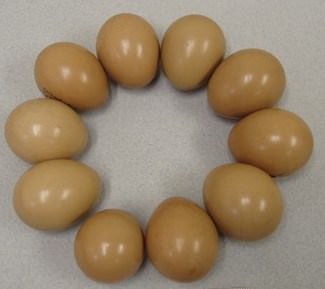The story of egg production at MacFarlane Pheasants is truly phenomenal! I have separated the procedures into two methods to explain what we do to make sure we get the thousands of eggs we need to produce the chicks and mature pheasants that are the life blood of MacFarlane Pheasants.
Inside Birds
- Light stimulation is started in the middle of December, resulting in our first eggs being ready at the end of December/early January.
- We typically start two barns of 3120 breeder hens.
- Birds are laying on bedding over concrete, so changing the grass/straw bedding is an everyday affair.
- We have one person, per barn, who picks eggs, who picks from 6 am to 4 pm, daily.
- Management is critical in tight space, so dust in barns and extreme temperatures outside mean we are adjusting barn temperatures and fans accordingly.
- The barn temperature is a constant 45 degrees.
- We pick eggs at a slow, careful, steady pace.
- At peak, both barns produce roughly 5300 eggs per day.
- Birds are moved to outside pens at the end of April or early May and eggs are continued to be picked.
Outside Birds
- We start light stimulation for some hens at the beginning of January, for our first eggs to be ready in the middle of February.
- Some birds are stimulated into production by natural light. By using both methods we have a steady flow of egg production throughout the season.
- 30,000 outside breeders are started.
- Huts are placed inside the pens to attract birds to lay eggs under them.
- Huts are strawed twice a month.
- We pick eggs in extreme elements (cold, ice, snow, heat).
- We pick these eggs with two crews of four men each.
- At peak production birds lay over 30,000 eggs per day.
- Each picker must pick around 3000 eggs per day.
Troy Cisewski ([email protected]) is the person to talk to if you would like more information about light stimulation to encourage birds to produce on a specific schedule.
